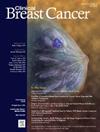在巴西的一个私人社区肿瘤实践中,激素受体阳性HER2阴性早期乳腺癌的真实世界治疗模式和结果。
IF 2.5
3区 医学
Q2 ONCOLOGY
引用次数: 0
摘要
目的:本研究旨在评估在巴西最大的社区肿瘤学实践网络中治疗的HR阳性(+)/HER2阴性(-)早期乳腺癌(EBC)患者的疾病特征、实践模式和现实世界结果。方法:回顾性研究2016 - 2021年Oncoclínicas&CO真实世界数据库。我们根据最近的辅助试验评估了风险概况分布(高风险[HR],中危[IR]或低危[LR]),包括EBC,内分泌和化疗(CT)处方和3年侵袭性无病生存(iDFS)。结果:共入选1786例。中位年龄为57岁,绝经前566例(32%),LR 1179例(66%),IR 351例(20%),HR 256例(14%)。绝经后患者中,74%的LR患者、79%的IR患者和83%的HR患者使用芳香化酶抑制剂(AI)。在绝经前患者中,卵巢功能抑制(OFS)联合他莫昔芬或AI用于18% LR患者,15% IR患者和48% HR患者。在LR、IR和HR组中,32%、38%和73%的绝经后患者接受CT检查。在绝经前患者中,LR组、IR组和HR组分别有55%、57%和78%接受了CT检查。3年iDFS在LR人群中为86% (95% CI, 84%-89%),在IR人群中为87%(82%-91%),在HR人群中为72% (95% CI, 65%-81%)。结论:在巴西私人环境中接受治疗的大量真实患者队列中,大多数患者被诊断为低风险EBC。我们发现有相当比例的绝经前高危EBC患者没有接受OFS治疗,也没有接受CT。本文章由计算机程序翻译,如有差异,请以英文原文为准。
Real-World Treatment Patterns and Outcomes in Hormone Receptor Positive HER2 Negative Early-Stage Breast Cancer in a Private Community Oncology Practice of Brazil
Purpose
This study aims to assess the disease characteristics, practice patterns and real-world outcomes of patients (pts) with HR positive (+)/HER2 negative (-) early breast cancer (EBC) treated in Brazil's largest network of community oncology practices.
Methods
Retrospective study from the Oncoclínicas&CO real-world database from 2016 to 2021. We assessed risk profile distribution (high-risk [HR], intermediate-risk [IR] or low-risk [LR]) as per recent adjuvant trials in EBC, endocrine and chemotherapy (CT) prescriptions and 3-year invasive disease-free survival (iDFS).
Results
In total, 1,786 cases were selected for the study. Median age was 57 years, 566 (32%) were premenopausal, 1,179 (66%) were LR, 351 (20%) IR, and 256 (14%) HR. In postmenopausal pts, aromatase inhibitor (AI) was used by 74% with LR, 79% with IR and 83% with HR. In premenopausal pts, ovarian function suppression (OFS) – combined with tamoxifen or AI – was prescribed to 18% LR pts, 15% IR, and 48% HR. CT was offered to 32%, 38%, and 73% of postmenopausal pts in LR, IR, and HR groups. In premenopausal pts, 55%, 57%, and 78% received CT in LR, IR, and HR groups. The 3-year iDFS was 86% (95% CI, 84%-89%) in LR population, 87% (82%-91%) in IR, and 72% (95% CI, 65%-81%) in HR.
Conclusions
In this large real-world cohort of patients treated in a private setting in Brazil, most pts are diagnosed with low-risk EBC. We found that a significant proportion of premenopausal pts with high-risk EBC were not treated with OFS and did not receive CT.
求助全文
通过发布文献求助,成功后即可免费获取论文全文。
去求助
来源期刊

Clinical breast cancer
医学-肿瘤学
CiteScore
5.40
自引率
3.20%
发文量
174
审稿时长
48 days
期刊介绍:
Clinical Breast Cancer is a peer-reviewed bimonthly journal that publishes original articles describing various aspects of clinical and translational research of breast cancer. Clinical Breast Cancer is devoted to articles on detection, diagnosis, prevention, and treatment of breast cancer. The main emphasis is on recent scientific developments in all areas related to breast cancer. Specific areas of interest include clinical research reports from various therapeutic modalities, cancer genetics, drug sensitivity and resistance, novel imaging, tumor genomics, biomarkers, and chemoprevention strategies.
 求助内容:
求助内容: 应助结果提醒方式:
应助结果提醒方式:


